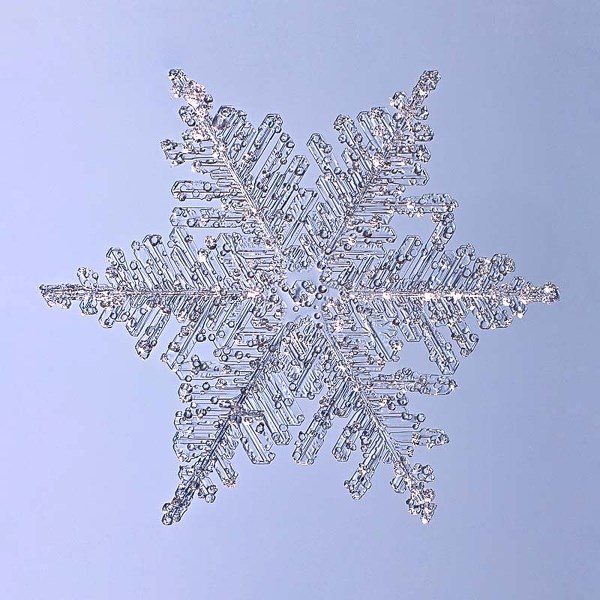I saw a beautiful snowflake on my window-screen once.
It was almost four millimetres across, with thin crystalline arms and broad, sparkling plates, and perfectly symmetrical.
"Look at me!" it seemed to say. "I am winter's wonder!"
I readied my camera and opened the window to get the dirty glass out of the way.
"Argh!" the flake probably said, as it atomized from the heat of my room.
"Aw," I said.
I am not good at shooting snowflakes.
Edmonton photographer Paul Burwell is much better than I, having studied and photographed them since 2009.
It's a painstaking process of waiting for the perfect flake to land on his sleeve and gently transferring it to a glass plate with a tiny paintbrush, all the while hoping it doesn't get shattered by the wind, his fingers, or a jealous rival flake.
Snowflakes are chunks of frozen water vapour, Burwell explains. Because water is a polar molecule, it always forms a hexagonal shape when it freezes – that's why all snowflakes have six sides.
"A lot of the time when the snowflakes are forming they'll bash into other snowflakes," Burwell notes. Most of the ones we see at ground level are misshapen, random and asymmetrical as a result.
How flakes form
Physicist Kenneth Libbrecht at the California Institute of Technology has spent years studying snowflakes as a model of crystal growth.
Snowflakes form through deposition, which is when water vapour turns directly into ice without condensing into liquid first, he explains.
"Water droplets will not freeze at 0 C," Libbrecht continues.
Pure water doesn't actually freeze until it hits about -40 C, he explains. Even though they want to, water molecules can't get into the right position to crystallize before then without help in the form of a nucleation point – a bit of dust, for example. Introduce one, and the molecules instantly glom together. Since they're already too cold to be liquid, they immediately become ice.
Every shape unique
What shape the flake takes depends on time, temperature and humidity.
Your most basic flake starts as a hexagonal prism and grows as vapour deposits on it, Libbrecht says. If atmospheric conditions are consistent across the width of the crystal, the flake will become symmetrical.
Any imperfection in the prism or difference in temperature or humidity on one part of the crystal will cause some parts of the flake to grow faster than others, making them closer to the surrounding vapour and letting them grow even faster. Eventually, you get branches, and then sub-branches.
"The faster the growth, the more ornate the crystal," Libbrecht says.
What's weird is how temperature and humidity changes affect this growth. For reasons that aren't clear, you get star-like plates at 0 to -5 C, thin needles from -5 to -15, and plates again below -15.
"It's complicated, and we don't even understand it all yet," Libbrecht says – not even after 75 years of research.
Flakes take anywhere from 15 minutes to an hour to form and can take hours to reach the ground, Libbrecht says. They generally take one of 35 to 80 different basic shapes, depending on the classification system you use.
The most common flakes are the irregulars, which are clumps of random crystals stuck together, Libbrecht says. The most popular are the stellar and fernlike stellar dendrites, which are the big multi-branched ones that make for great powder when skiing.
You've also got 12-sided flakes, triangular ones and ones shaped like bullets. There's even the microscopic hollow column, which is a column with two cone-like indents in either end.
Burwell's favourite is the sectored plate, which has a hexagonal centre and six plates coming out of it.
"It looks more like a jewel to me."
Libbrecht prefers the capped column, which resembles an empty spool.
My odds of finding another flake exactly the same as the one I melted are pretty much nil due to math, Libbrecht says – given the number of molecules in a typical flake and the number of ways you can arrange them, there are more possible flakes than there are atoms in the universe. My odds would be much better if I had seen a nano-scale flake of just a few molecules, he adds.
Still, one can hope, which is why I'll keep a close eye on the next snowfall.
Scientific St. Albert
Like science? So do we! Scientific St. Albert looks at a simple, common phenomenon in the St. Albert region and explains it with the help of local scientists every other week.
Got a burning scientific question? Send it in to [email protected].




